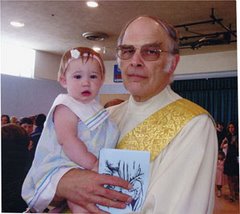John 18:1-19:42
The Passion we read on Good Friday is taken from the Gospel of John. It’s long and there are so many things we could think about. Towards the end of the gospel we hear this passage: “Standing by the cross of Jesus were his mother and his mother’s sister, Mary the wife of Clopas, and Mary Magdala. We also assume the disciple whom Jesus loved was there as well, since Jesus spoke to him from the cross.
Mary, his mother, was there. Long ago when she was a teenager she had a vision of the angel Gabriel, who informed her that she was to become the mother of the Redeemer. And Mary said “Be it done to me as you say”. She didn’t know what she was getting into. None of us do when we tell God to use us as he wishes to use us. Mary speaks two more times in scripture -- when she says to Jesus “Son, why did you do this? Your father and I have been searching for you”. And another time, when she tells the waiter to “do whatever he tells you”. If you had met Mary you would probably not have been impressed. She probably wore something like a hijab when she went out of her home. Her clothing was coarse, and she probably had woven the cloth herself. If you saw her on the streets of Nazareth she would be carrying a basket, taking something from her garden to the market, bringing something else home. And every day was like every other day, except when Jesus was lost; except when she and her family celebrated a Jewish holiday; except when Joseph died, and except when she heard about the fact that her son was going to be executed. And she is standing there, looking at her son, suffering with him, her heart broken. The one God chose as his mother, the woman conceived without sin, the most perfect human -- and yet she isn’t spared pain and poverty and all the sufferings human life offers. Can we expect otherwise?
Then we meet Mary, the wife of Clopas, the sister of Jesus’ mother, according to John. In the gospel of Luke two disciples of Jesus were on the road to Emmaus, despondent because the one they thought would save Israel had been crucified. One was named “Cleopas”. It’s not unlikely that the other was his wife. Some of the Christian writings that never made it into the bible said that Cleopas, or Clopas, was the brother of Joseph. It would seem unlikely that Mary’s parents would have named two daughters “Mary”, so if all this is true, Mary’s sister was probably her sister in law. Mary, the wife of Clopas must have made an impression on the early Christians, because she is probably the Mary in Mark who is the mother of James and Joses, two of Jesus’ cousins. I suspect that Mary of Clopas and Jesus’ mother were good friends, and Mary of Clopas is there,risking her own life to lend support to her sister in law. She is an example of real friendship, the kind that we Christians are called to. Do we go out of our way to comfort those we know who are on the margins, who are ill, who are old and unable to get around anymore? True friends are there when you need them the most and don’t drift away like Jesus’ other friends.
And there is Mary Magdalene. I picture her as younger -- Maybe because I was heavily influenced by that old Movie, “Jesus Christ, Superstar”. In the movie and the broadway musical, Mary Magdalene is depicted as someone who is more or less smitten by Jesus -- she’s in love with him. And that’s consistent with some of the early Christian writings as well, where she is depicted as Jesus’ confidant, his closest disciple. We really don’t know much about Mary’s background -- all we know is that Jesus at some point drove seven devils out of her. Mary was lost -- possessed -- and then rescued by Jesus. No wonder she loves him. And she is at the foot of the cross, grateful. And after the resurrection her loyalty and love will be rewarded because she will be the first to meet the risen Lord. She is the apostle to the apostles.
And finally there is the beloved disciple. Down through the ages that individual is identified with the writer of the gospel of John, who in turn is thought to be the apostle John. But neither is true. John’s gospel is very different from the others, and emphasizes Jesus’ divinity. And whenever you meet the beloved disciple, John wants you to put yourself there, in that scene. It’s like a place marker for his readers. And in this place John invites you to put yourself at the foot of the cross, and think about what God has done for you in the person of Jesus, and how the church springs forth from his side when he is lanced, and how he offers his mother to be your mother, and how he is the perfect image of the Father’s love.
So today on Good Friday you are there -- with his mother, with her best friend, and with the woman who loves him because of what he has done for her. YOu are the beloved disciple. Go and tell everyone you know that they are beloved as well.



































